Losing the Bottom (07F-3)
Friday, I was walking home along the beach. North of the Santa Monica Pier two lifeguards passed me northbound and yelled out a greeting as I picked up skipping rocks. It has been a long time since I've seen a familiar face. I yelled back and we continued, they north, me south. They caught me up just at the south edge of the pier and the conversation continued as we jogged along. I was surprised that I could both keep up and talk. That might not have lasted much longer but I would never find out as there, at theKenter Creek outfall, was a lovely 8-foot bluff cut in the beach.
"Sorry, guys, I can't resist this."
"OK. We turn at Tower 20, anyway."
During the summer the sand builds up at the drain outfalls. Then a rainstorm comes in the winter, the water backs up and then suddenly cuts though. The result is a tall face of reasonably packed sand that works for large-scale vertical relief sculpture. Big tunnels, loops, curves, and then sudden collapse. It gives no warning of impending collapse. At least I didn't have to pack it. This is the usual end of R-type sculptures. I moved a few feet over and started another. Two girls joined me, never having thought about carving such a thing. I was sitting at the foot of the bluff, tunnelling behind an element when the whole thing landed in my lap. A bit too vertical. The next one angled into the bluff but wasn't developed all that far because my arms were tired from moving the mass of sand.
Would that count for the weekend's sculpture? Well, ending things with failures isn't that attractive. The day was spectacularly clear, and cold. I was wishing I'd started a real sculpture. Saturday started with reading but bright sunlight brought me outdoors. I had no idea what the sand would be like; storms tend to take it away. I loaded what I needed onto the cart and headed out around 0800.
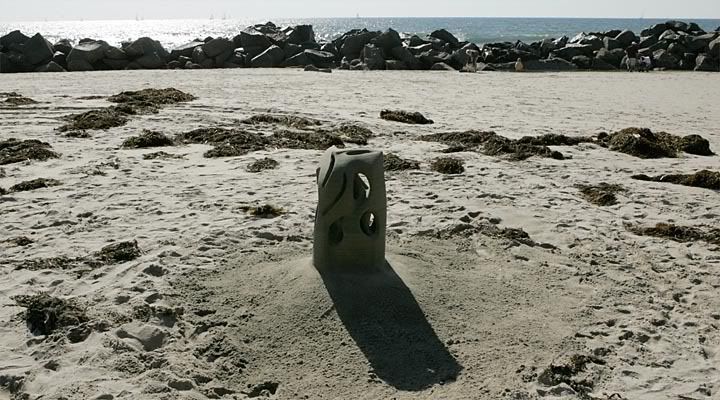
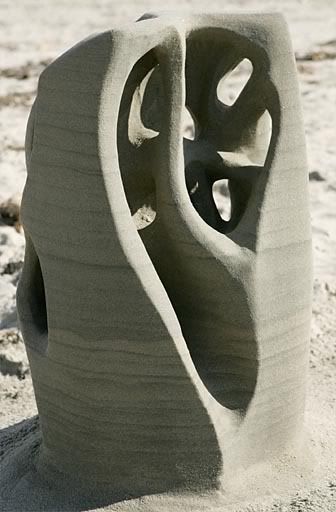
I couldn't resist building up on the flat. It's a better stage and has water on three sides. The first load of sand came from the best spot I could find quickly but after packing that I realized I had plenty of time so I ranged more widely in search of better sand. I found it in a small area and used that for the rest of the sculpture, which is why the lower third is lighter in color. You can see that in the image above.
The sculpture's initial idea was derived from the previous day's relief experiments. I wanted to make the side of the sculpture undulate around a space. I carved that part and then the rest just pretty much happened. You can see that initial space in the upper right of the image below.
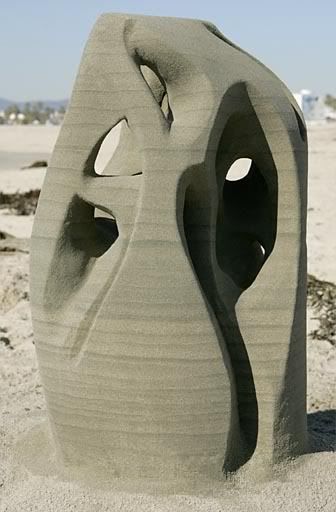
Many recent larger sculptures have had detailed upper sections sitting on a lower part that's just more or less there to keep the rest off the beach. The form I use for those is 42 inches tall. The form I used for this one is 30 inches. Without the worry of an extra foot of mass sitting up there the lower part can be just as detailed.
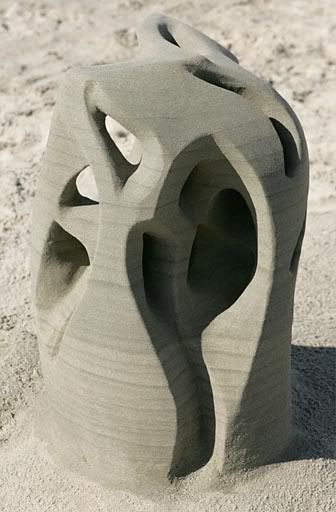
So, I can eliminate the time taken by packing that lower sand, and I don't have to carry it. The surprise was that carving even a small sculpture like this can expand to fill the day. I quit on this one only because I needed to get home for another event. In 1984, sculptures were four feet tall. By 1995 they'd grown to six and a half feet, using this small form as an extension. Late in the year I experimented with using the short form as the main part and learned that it worked. I put an extension on top to make it taller and started the "Small Sculpture Revolution," based on the idea that if I made all the elements half as big I'd only have to pack about 1/8th as much sand. Eventually I settled on about 1/3d the sand. Now it seems that even less sand is needed. The sculpture is relatively stubby, being only about 1.5 times taller than it is wide. Predecessors were about twice as tall as they were wide. I guess I can call this the "Smaller Sculpture Revolution."


Freed from the heavy engineering constraints of tall sculptures, I have no idea where this form factor might lead. When I first started doing short-form sculptures they were parts of larger sculptures. This one is a sculpture of its own scale, having all the elements of a larger one but shrunken. The problem is access: smaller holes are harder to get into. I need to make some new tools.
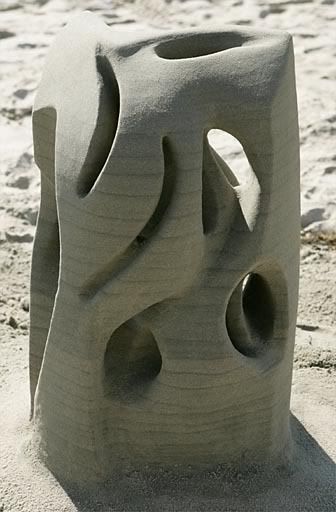
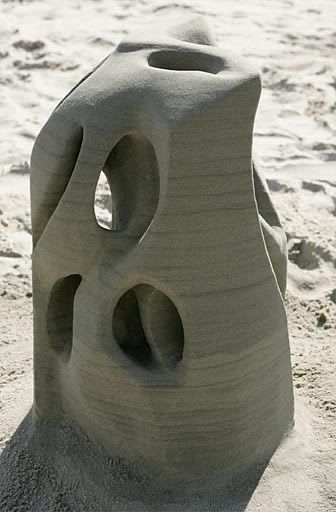
I'm sorry I couldn't wait for sunset. This one would have lit up nicely, I think. It was fun to make. It takes time to get used to a new form factor, and I'm gradually shaking off the assumptions of the past regarding this short form. This is helped by the continuing availability of good sand, a real gift at this time of year.

"Sorry, guys, I can't resist this."
"OK. We turn at Tower 20, anyway."
During the summer the sand builds up at the drain outfalls. Then a rainstorm comes in the winter, the water backs up and then suddenly cuts though. The result is a tall face of reasonably packed sand that works for large-scale vertical relief sculpture. Big tunnels, loops, curves, and then sudden collapse. It gives no warning of impending collapse. At least I didn't have to pack it. This is the usual end of R-type sculptures. I moved a few feet over and started another. Two girls joined me, never having thought about carving such a thing. I was sitting at the foot of the bluff, tunnelling behind an element when the whole thing landed in my lap. A bit too vertical. The next one angled into the bluff but wasn't developed all that far because my arms were tired from moving the mass of sand.
Would that count for the weekend's sculpture? Well, ending things with failures isn't that attractive. The day was spectacularly clear, and cold. I was wishing I'd started a real sculpture. Saturday started with reading but bright sunlight brought me outdoors. I had no idea what the sand would be like; storms tend to take it away. I loaded what I needed onto the cart and headed out around 0800.


I couldn't resist building up on the flat. It's a better stage and has water on three sides. The first load of sand came from the best spot I could find quickly but after packing that I realized I had plenty of time so I ranged more widely in search of better sand. I found it in a small area and used that for the rest of the sculpture, which is why the lower third is lighter in color. You can see that in the image above.
The sculpture's initial idea was derived from the previous day's relief experiments. I wanted to make the side of the sculpture undulate around a space. I carved that part and then the rest just pretty much happened. You can see that initial space in the upper right of the image below.

Many recent larger sculptures have had detailed upper sections sitting on a lower part that's just more or less there to keep the rest off the beach. The form I use for those is 42 inches tall. The form I used for this one is 30 inches. Without the worry of an extra foot of mass sitting up there the lower part can be just as detailed.

So, I can eliminate the time taken by packing that lower sand, and I don't have to carry it. The surprise was that carving even a small sculpture like this can expand to fill the day. I quit on this one only because I needed to get home for another event. In 1984, sculptures were four feet tall. By 1995 they'd grown to six and a half feet, using this small form as an extension. Late in the year I experimented with using the short form as the main part and learned that it worked. I put an extension on top to make it taller and started the "Small Sculpture Revolution," based on the idea that if I made all the elements half as big I'd only have to pack about 1/8th as much sand. Eventually I settled on about 1/3d the sand. Now it seems that even less sand is needed. The sculpture is relatively stubby, being only about 1.5 times taller than it is wide. Predecessors were about twice as tall as they were wide. I guess I can call this the "Smaller Sculpture Revolution."


Freed from the heavy engineering constraints of tall sculptures, I have no idea where this form factor might lead. When I first started doing short-form sculptures they were parts of larger sculptures. This one is a sculpture of its own scale, having all the elements of a larger one but shrunken. The problem is access: smaller holes are harder to get into. I need to make some new tools.


I'm sorry I couldn't wait for sunset. This one would have lit up nicely, I think. It was fun to make. It takes time to get used to a new form factor, and I'm gradually shaking off the assumptions of the past regarding this short form. This is helped by the continuing availability of good sand, a real gift at this time of year.
